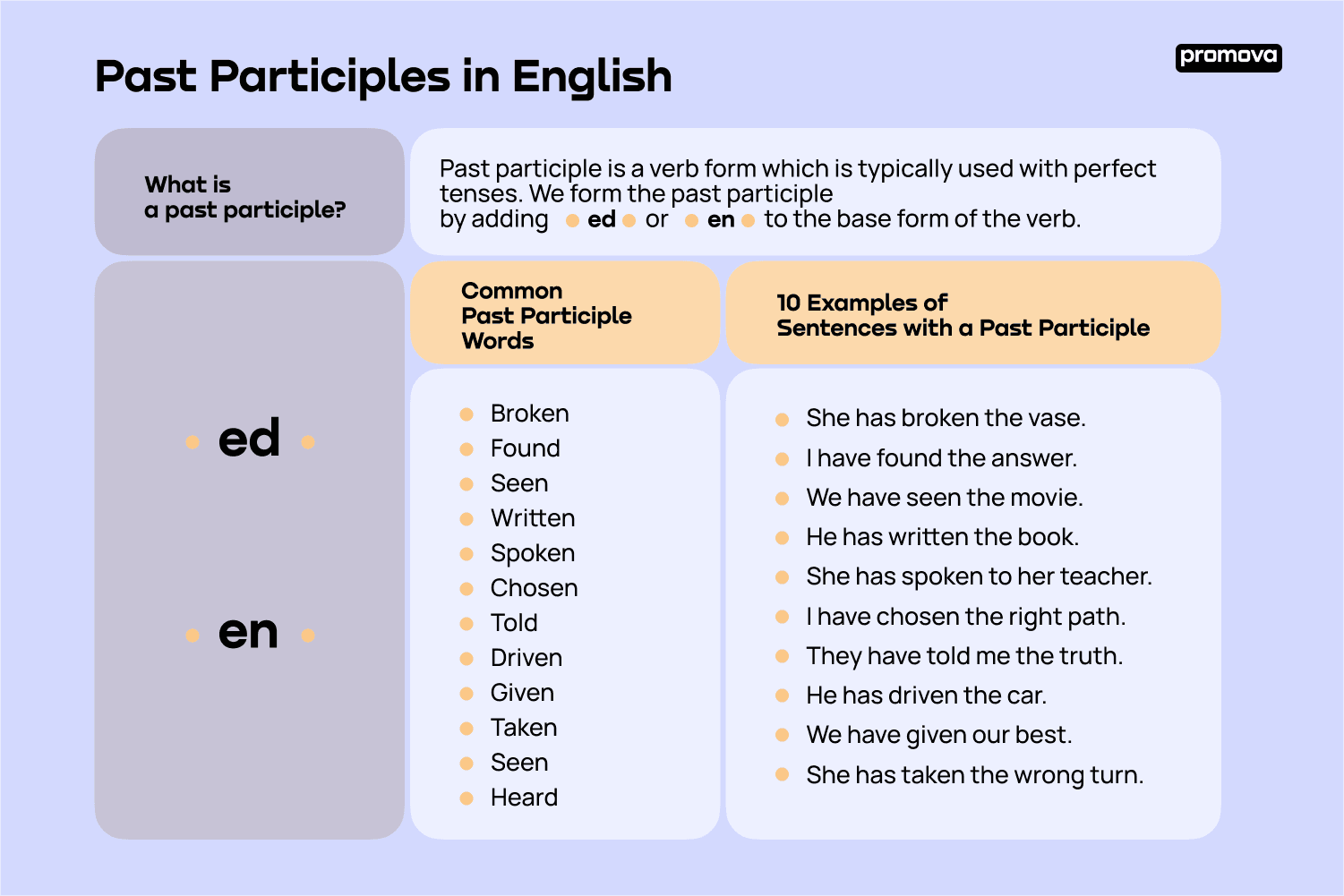Past Participles in English
Contents
In this reference, we will discuss what a past participle is, common past participle words when to use a past participle, tips for using past participles, and the difference between past participles and present participles. We will also look at 10 examples of past participles used in sentences.
What is a past participle?
Past participle is a verb form which is typically used with perfect tenses. It can also be used as an adjective or noun in some cases. It always ends in -ed or -en. It is important to understand past participles to communicate effectively in English.
We form the past participle by adding -ed or -en to the base form of the verb. For example, the past participle of “walk” is “walked.” Similarly, the past participle of the verb “talk” is “talked.”
The past participle is often confused with the present participle, and it is important to be able to differentiate between the two. We form the present participle by attaching -ing to the base form of the verb. For example, the present participle of the verb “walk” is “walking.” Similarly, the present participle of the verb “talk” is “talking.”
So, there's a major difference between the past participle and the present participle. The past participle is used to describe an action that has already been completed, whereas the present participle is used to describe an action that is currently taking place.

Common Past Participle Words
There are many common past participle words that are used in English. Some of the most commonly used past participle words include:
- Broken
- Found
- Seen
- Written
- Spoken
- Chosen
- Told
- Driven
- Given
- Taken
- Seen
- Heard
There are a lot more past participle words in English. With time, you'll learn a lot more of them!
When to Use a Past Participle
We use the past participle with he perfect tenses. The perfect tenses are used to describe an action that has already been completed.
For example, the sentence “I have spoken to my teacher” is in the present perfect tense. The past participle “spoken” is used here to describe the action of speaking that has already taken place.
The past participle can also be an adjective or a noun. For example, the sentence “The broken window needs to be fixed” uses the past participle “broken” as an adjective to describe the window.
3
Past Participles vs Present Participles
As mentioned before, it is important to understand the difference between the past participle and the present participle. The past participle is used to describe an action that's already done, whereas the present participle helps describe an action that is currently taking place.
For example, the sentence “I have spoken to my teacher” is in the present perfect tense. The past participle “spoken” is used here to describe the action of speaking that has already taken place.
In contrast, the sentence “I am talking to my teacher” is in the present continuous tense. The present participle “talking” is used here to describe the action of speaking that is currently taking place.
10 Examples of Sentences with a Past Participle
Here are 10 examples of sentences with a past participle:
- She has broken the vase.
- I have found the answer.
- We have seen the movie.
- He has written the book.
- She has spoken to her teacher.
- I have chosen the right path.
- They have told me the truth.
- He has driven the car.
- We have given our best.
- She has taken the wrong turn.
These are just a few examples of sentences with a past participle. Here are some more complex sentences:
- The students have been given the assignment.
- The team has already taken the lead.
- The cat has been chosen as the mascot.
As you can see, the past participle can greatly improve the clarity of our speech.
Summary
Past participles are verb forms typically used with perfect tenses. It can also be used as an adjective or noun in some cases. It always ends in -ed or -en.
Now that you have learned about past participles in English, why not put your new knowledge to the test by trying to write some sentences with it? Take a look at the resources below for more help!
Comments